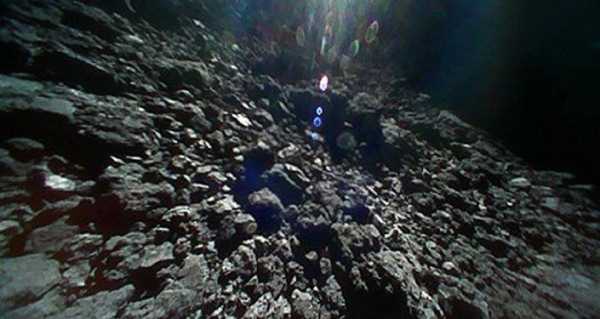
Japan’s Aerospace Exploration Agency’s (Jaxa) first Hayabusa mission in 2010 brought back a tiny sample of the asteroid ‘Itokawa’, located about a billion miles away, beyond Mars, after the probe’s sampling collection device failed, but picked up microscopic grains of dust during landing.
Scientists have discovered water and organic matter on the surface of a tiny asteroid sample, collected from the solar system.
The single grain hails from the celestial rock dubbed ‘Itokawa’ and was retrieved by the Japan Aerospace Exploration Agency’s (Jaxa) first Hayabusa mission in 2010.
The asteroid in question is designated a near-Earth object of the Apollo group – a potentially hazardous asteroid.
It was first discovered by the Lincoln Near-Earth Asteroid Research (LINEAR) project in 1998 and later named after Japanese rocket engineer Hideo Itokawa.
According to researchers from Royal Holloway, University of London, their studies show that the asteroid – the smallest one ever photographed and visited by a spacecraft – had been evolving for billions of years, incorporating liquid and organic material in a manner similar to planet Earth’s.
The research, entitled “Organic matter and water from asteroid Itokawa” and published in the journal Scientific Reports, offers a glimpse into how the asteroid evolved, enduring extreme heat, dehydration, and shattering, only to use material it picked up on its travels to rehydrate and re-form.
The study also underscored that S-type asteroids, consisting mainly of iron- and magnesium- silicates, and the ones most often frequenting Earth, can contain raw components of life.
The findings on the grain, nicknamed ‘Amazon’, have been hailed as able to rewrite previous studies of the history of life on planet Earth, which focused on carbon-rich C-type asteroids.
The international collaboration of scientists found both primitive (unheated) and processed (heated) organic matter within ten microns (a thousandth of a centimetre) of distance.
The scientist added that the current revelations provide a further insight into the details of an asteroid’s history. Furthermore, they suggest that the celestial rock’s evolution route is strikingly “similar to that of the prebiotic Earth”.
Looking ahead, further analysis of the sample in question may set the groundwork for studies of other samples, such as the black grains retrieved by Jaxa’s Hayabusa2 mission from asteroid Ryugu last year.
The successor mission was launched on 3 December 2014 and rendezvoused in space with asteroid Ryugu on 27 June 2018.
The Japan Aerospace Exploration Agency (JAXA) confirmed on 14 December 2020 that a capsule only 38 cm across had brought back for the first time subsurface samples of an asteroid back to Earth.
Sourse: sputniknews.com






